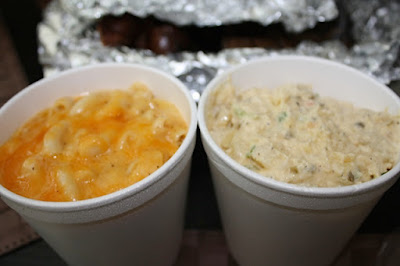 |
| Turkey brined for 12 hours |
 |
| My 12-lb brined turkey getting ready to go under |
I've read all the various ways of preparing a smoked turkey -- whether to wet-brine, dry-brine, no-brine, inject, etc. Since this was my first time, I decided to try a little bit of everything. I submerged the turkey into a brining solution with some:
- Apple juice
- Brown sugar
- Kosher salt
- Honey
- Oranges
- Peppercorns
- Garlic
- Bay leaves
Since I read that brining can cause the turkey to taste a bit "mushy," not to mention take away some of that meaty flavor, I decided to just brine the turkey for about 12-15 hours. I patted the turkey nice and dry, then gave it a good massage of olive oil and seasoning rubdown which included the following:
- Seasoned salt
- Black pepper
- Garlic powder
- Paprika
- Cayenne
For good measure, I also injected the turkey with the star ingredient -- Corona beer!
- 1 bottle of Corona
- Melted butter
- Paprika
- Cayenne
 |
| After 3 hours of smoking in the WSM |
 |
| I had about 3 plates! |
After 3 hours of smoking the turkey in the WSM (with 2 fist-sized apple wood chunks), the turkey came out with a nice, mahogany colored skin crust. When I measured the temperature of the breast, it was around 170-175 degrees F. Since I was targeting the magic number of around 160-165, I was afraid the breast meat would be too dry. Next time, I will need to check the temperature a bit earlier (I got caught up finishing the side dishes!).
After letting the turkey rest for about a half hour, I sliced the turkey wide open. The breast was still reasonably moist. The slight hint of smoke was perfect -- not overpowering at all. The dark meat was full of flavor too. I used the pan drippings to make the gravy and it was the perfect compliment to the turkey. For my first time smoking turkey, I thought everything tasted great.
The one thing I noticed (and knew from the start) was that the skin wasn't as extra crispy (compared to an oven cooked turkey) --which was a result of the lower smoking temperature. From the start, I tried to maintain a temperature in the WSM of at least around 325-350 for all 3 hours, but it was a challenge. I would say the average temperature was more like around 300. Other than that, I thought my first time smoking a turkey was a success. I'll be smoking turkey more often in future years, and hope to get better.






















































